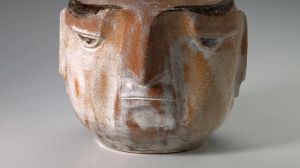
Marguerite Wildenhain, Bauhaus potter, settled in Pond Farm, California, ca. 1958. Photograph by Otto Hagel, © Center for Creative Photography, The University of Arizona Foundation
Overview
A significant figure in 20th-century ceramics, Marguerite Wildenhain brought rigor and modernist clarity to the American studio pottery movement. The works on view in A Kin to Clay exemplify her expressive yet disciplined approach to form. Functional in concept but sculptural in presence, these pieces reflect her belief in the pot as a site of both utility and personal expression. A master of form and pedagogy, Wildenhain shaped generations of artists, among them Frances Senska, through workshops she held at Pond Farm, the artist colony and pottery she established in Northern California.
2025 Exhibition Season
For its 2025 exhibition season, Tinworks Art presents A Kin to Clay, an exhibition that honors the rich legacy of ceramics in Montana while tracing its connections to broader histories and cultural lineages. Through the work of artists who engage clay and earthen materials as vessels of memory, resistance, and community, the exhibition explores how a shared relationship to the earth can shape meaning across generations and geographies.
About the Artist
Trained at the Bauhaus as its first female master potter, Marguerite Wildenhain brought rigorous techniques and modernist philosophies to the American studio pottery movement through her teaching, published works, and pottery. After fleeing the Nazi regime twice, she founded Pond Farm, a ceramics workshop in Northern California that became a vital center for craft education for more than forty years. Her legacy is marked by a commitment to discipline, form, and the expressive potential of functional pottery. Also influential was Wildenhain’s philosophy that pottery was not just a practice but a way of life, one that merged technical skill with a love of nature and craft.


